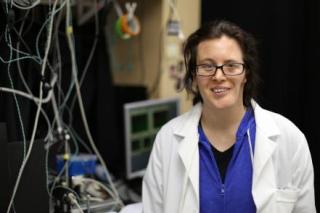Apr 17 2015
A team of Michigan State University researchers has discovered a switch that regulates plant photosynthesis – the process that lets plants store solar energy and use it to grow and produce food.
 Deserah Strand, MSU postdoctoral researcher, has discovered a switch that regulates plant photosynthesis – the process that lets plants store solar energy and use it to grow and produce food. Photo by David Kramer
Deserah Strand, MSU postdoctoral researcher, has discovered a switch that regulates plant photosynthesis – the process that lets plants store solar energy and use it to grow and produce food. Photo by David Kramer
Photosynthesis stores energy in two forms that are used to power plants’ metabolism. The amount of energy flowing into each of these must be perfectly balanced to match the needs of plants’ metabolism or the plant will self-destruct.
The results, featured in the current issue of Proceedings of the National Academy of Sciences, focus on what happens when photosynthetic output becomes unequal and plants begin to produce toxins that must be immediately addressed.
The MSU-led team, headed by David Kramer, MSU Hannah Distinguished Professor in Photosynthesis and Bioenergetics, was able to show that one of these toxins, hydrogen peroxide, signals for the activation of an alternative photosynthetic pathway called cyclic electron flow, or CEF.
Identifying the function of this switch may aid in the development of plants with improved efficiency and resilience to environmental stresses, which could help ease global demand for food and fuel as climate changes.
“Over the next 30 years, we need to dramatically increase our food production to keep up with the demands of a growing global population as well as environmental changes, which are likely to impact crop productivity,” Kramer said.
CEF is a highly researched, but still poorly understood route of electron transfer in plants, said Deserah Strand, co-author and MSU postdoctoral researcher. In order to meet the constantly fluctuating demands of the plant cell, alternative pathways like CEF must be rapidly turned on and off.
As plants and algae metabolism are modified to meet the global demand for food and fuel, it is important to understand how photosynthesis will need to adjust to the changes, said Strand.
“Simply increasing solar energy flow into the plant without balancing it to match metabolism would be counterproductive or even deadly to the cell,” she said. “The energy must be finely regulated and balanced.”
Although plants quietly and efficiently master this energy transfer, photosynthesis remains a highly volatile process.
“Increasing plant productivity is difficult, partly because photosynthesis is inherently dangerous as it involves some of the most-reactive chemical substances in biology,” Kramer said. “We knew that CEF was an important process in photosynthesis, particularly under environmental stresses like drought, cold or heat, but we did not know how it was regulated. Now we have a handle on one of the important triggers.”
Additional MSU researchers aiding this study include Mio Satoh-Cruz and John Froehlich. Scientists from Washington State University and the Heinrich-Heine-Universitat (Germany) also contributed to this paper.
This research was funded by the U.S. Department of Energy Office of Basic Energy Science.
Source: http://www.msu.edu/